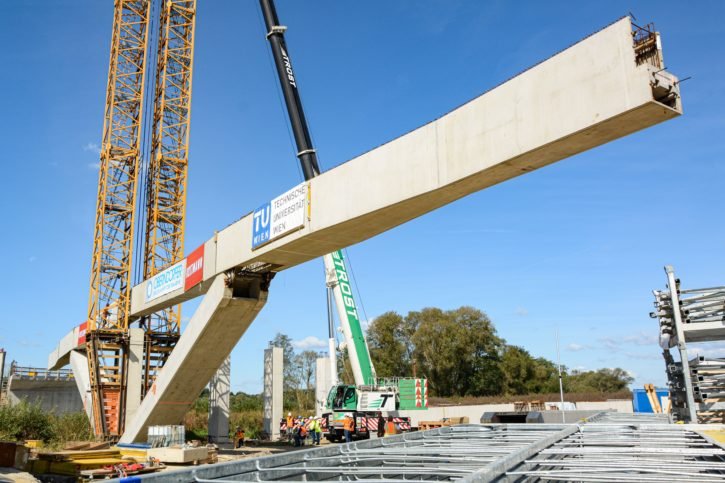Header Title
Bridging rethinks – vertical, circular, movable and on demand
Bridge design normally thinks horizontally – until creative engineers rethink the basics
Bridge design is a historical discipline with a massive legacy mindset of complexity, expense and one-off, manpower-intensive processes. But sometimes – even after thousands of years of bridges – creative engineers are able to rethink some of the basics.
Bridge building is essentially about spanning horizontal distance. And in its modern iterations there are usually two basic approaches – either casting concrete in situ using complex shuttering, or assembling bridge sections and components – using a range of different materials – constructed offsite.
Balanced lowering
However, in an (apparently) new technique developed by TU Wien in Austria the bridge is not built horizontally. Instead, it is erected in a central, vertical position and then “unfolded” down to the horizontal, right on the spot. In February 2020, ASFINAG (the Austrian federal agency for motorways and expressways) successfully used this procedure for the new Lahnbach and Lafnitz bridges to carry the Fürstenfeld motorway.
in balanced lowering, the span girders are lifted and mounted into a vertical position on opposite sides of a central pier – connected to each other at the top, directly above the pier. A hydraulic system then slowly lowers the high-point bridge centre so the girders slide out to the sides to extend over the horizontal span – somewhat like unfolding an umbrella. The girders on each side balance each other perfectly in weight and the alignment of forces (unless the wind is strong and/or tricky, one assumes).
The girders themselves consist of thin-walled prefabricated elements with steel reinforcement, and are hollow. Once they’re in the final horizontal position they get filled with concrete. This is a relatively straightforward process that does away with much of the time-consuming, manpower-intensive and expensive needs for scaffolding and shuttering for casting concrete in complex shapes.
Low-impact thinking
Traditional methods of erecting bridges usually take months, whereas the elements used in the balanced lowering method can apparently be set up in a few days, with the actual lowering process only taking about three hours. This new construction method therefore saves time as well as money and resources.
The balanced lowering method (or lifting method, when used the “opposite” way to construct bridges with high piers) is particularly advantageous for sites in difficult terrain or in landscapes where it’s important to keep disturbances to a minimum – for example a nature reserve, as was the case for the Lahnbach/Lafnitz bridges.

Bridge in horizontal position after unfolding Photo: TU Wien
All in all, it seems to make it possible to provide a key item in transport (vehicles, trains, bikes, pedestrians, animal passages, ??) infrastructure with less environmental impact and habitat disturbance than with traditional construction methods. This perhaps also paves the way to more subtle dialogue over the conventional infrastructure versus nature confrontations.
Bridging on demand, deconstructed, etc.
With creative thinking and innovative engineering of such kinds, bridges don’t have to be static structures or high-impact edifices, expensively moulded on site. Thinking differently makes it possible to move from practical necessity to visual enrichment and functional artwork.
A now-iconic example of such everyday magic is the Rolling Bridge at Paddington Basin in London, installed in 2002 and designed by Heatherwick Studio, working with structural engineers SKM Anthony Hunts. Actually, it’s really an “un/curling bridge”, consisting of relatively simple modular elements, fused together with a great idea.
Not far away at Merchant Square is the Fan Bridge, designed by Knight Architects and opened in 2014. It rises gracefully to allow boats to access the head of Paddington Basin. It is a delightful visual deconstruction of the traditional bridge span, and a captivating source of wonderment and delight for residents as well as tourists.
Bridge porn
Moveable bridges provide much greater scope for conceptual fireworks and engineering ingenuity, and actually constitute their own particular category of bridge porn. Go fish on YouTube if you want your faith in engineering restored or re-envigorated. But it’s worth remembering that it’s the rethink of the millennia-old idea of the bridge that comes before the technical implementation.

